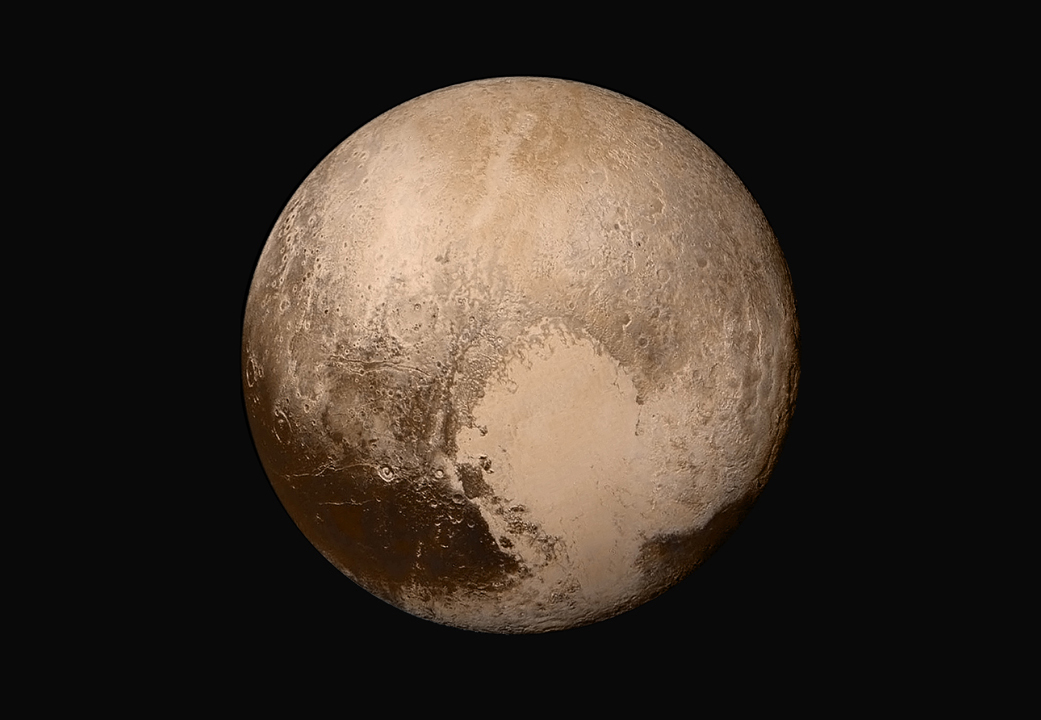

Mike Brown doesn’t hate Pluto. The Caltech astronomer is a self-professed Pluto killer—by discovering Eris, an icy world similar in size to Pluto, Brown’s work led to both worlds getting classified as ‘dwarf planets’ in 2006. Nevertheless, he’s avidly following all the news coming from NASA’s flyby of the former planet.
For Brown, Pluto provides a glimpse of Eris and the other worlds he discovered at the edge of the solar system. “With Pluto and Charon, you get a whole range of ideas about how large Kuiper Belt Objects behave,” he says. “I look at Pluto, but I also see in my head a little bit of Eris and Makemake. Quaoar is probably halfway between Pluto and Charon, with those old impacted areas but also the sort of reddish hue.”
If Pluto were a planet, then many of the worlds Brown discovered would also be planets, meaning he would have discovered more solar system planets than any individual in human history. Which would be really cool, he says, “but it would just feel kind of fraudulent.”
The flood of new worlds at the outskirts of our solar system is exactly what led to Pluto’s demotion. There are at least four would-be planets out there in the farthest reaches of the solar system, and more are likely hiding in the crowded Kuiper belt. Scientists still can’t entirely agree on what to do with this hodgepodge of small, icy worlds.
The New Horizons spacecraft’s flyby of Pluto on July 14 is making the former planet come alive. High-resolution images have put a face on this once-mysterious world. We’ve probed its atmosphere and imaged its moons for the first time. Icy peaks rivaling the Rocky and Appalachian Mountains slice through its lower atmosphere, and nitrogen glaciers have carved up its surface sometime in recent geological history. “What else would you call it besides a planet?” says New Horizons mission leader Alan Stern.

Defying the International Astronomical Union (IAU), which names objects in space and redefined Pluto’s status in 2006, Stern and his colleagues have been calling Pluto a planet during NASA’s televised events. This Pluto pandering does a disservice to the public, says Brown. “As an educator, I would like people to understand what our real solar system is like, not a cartoon of it. Calling Pluto a planet is like a cartoon solar system all over again.”
If this feels like déjà vu, it’s because the Pluto flyby has predictably revived a bitter debate about how best to define a planet.
Size Matters
On one side of the debate you have scientists who say size matters. According to the IAU, a “planet” is an object that a) orbits the Sun; b) has enough gravity to be round; and c) is large enough to clear its orbit of debris.
Since Pluto inhabits the crowded Kuiper belt, it fails in the third category. So do Eris, Haumea, Makemake, and Ceres. Instead of letting the solar system become too crowded, the 2006 IAU definition excludes these runts.

“People who call Pluto a planet think of it as a large object in the solar system,” says Brown. “It’s not even as big as the moon. If you’d arrived from another solar system, you’d immediately notice 8 really big bodies and a ton of little bodies in between,” says Mike Brown.
And, even though Pluto has moons, an atmosphere, and a dynamic surface, the scientists on this side of the debate argue that those things aren’t enough to qualify Pluto as a planet. Most of the solar system’s largest bodies have seen geological activity in their past. Even comets can have atmospheres and complex surfaces, says planetary scientist Carolyn Porco, and asteroids can have moons. Geological characteristics are not even a part of the IAU’s definition.
Size Doesn’t Matter
Some planetary scientists, such as New Horizons’ Alan Stern and the Dawn mission’s Mark Sykes, aren’t buying the “size matters” argument. They think that any object that orbits the sun and has enough gravity to pull itself into a spherical shape should be called a planet. “When they get that size, that’s when geology turns on,” Sykes told Popular Science during an interview in January.
Scientists on this side of the debate don’t like the IAU’s definition since it depends on a world’s neighborhood instead of its intrinsic properties. If Earth were placed in Pluto’s position, it wouldn’t clear its orbit either, says Stern.
And although Earth’s diameter is five times larger than Pluto’s and that may seem like a big difference, Saturn and Jupiter are 9.5 and 11 times the size of Earth, respectively. Going off of just size alone, the line that separates real planets from minor planets could easily be drawn to exclude Earth.

The IAU’s definition is also only applicable to our solar system. For the planets that orbit other suns, the IAU will come out with a separate definition—an interesting choice for an organization whose goal is to standardize conventions and ensure consistency.
Scientists now estimate that there are billions of these exo-worlds in our galaxy–that planets are not nearly as special as we once thought. Maybe it’s time to extend that philosophy to our own solar system.
Will Pluto Ever Be Reinstated?
After Ceres was discovered in 1801, it was considered a planet for a few glorious decades. Then, as astronomers discovered more and more objects in Ceres’ neighborhood, the little planet was reclassified. More than 150 years later, Ceres remains the largest object in the Asteroid Belt, but a mere dwarf planet. Similarly, Pluto may have to settle for its title of “King of the Kuiper Belt.”
The IAU has given no indication that it plans to change its definition of planet. Meanwhile, planetary scientists will likely just go ahead and continue to call Pluto a planet. “Nobody has changed their minds,” says Brown, “it’s just that people have gotten louder.”
